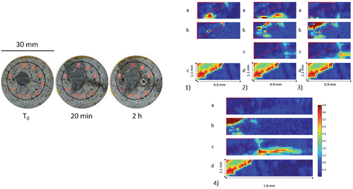In situ monitoring of corrosion processes by coupled micro-XRF/micro-XRD mapping to understand the degradation mechanisms of reinforcing bars in hydraulic binders from historic monuments
Abstract
Historic monuments have been partly built since antiquity with iron or steel reinforcements sealed in mortars or hydraulic binders. But the presence of chloride in the environment can weaken the structures due to the corrosion of these metallic parts, leading to the cracking of the binder. In this context, in order to better understand the first steps of these corrosion mechanisms a chemical cell was designed to operate in situ analyses of the phases precipitated when a chlorinated solution is introduced in the vicinity of the bar. The chemical and structural characterization (micro-XRF and micro-XRD respectively) was performed under synchrotron radiation at the SOLEIL-DiffAbs beamline. Moreover, complementary SEM-EDS analyses were carried out before and after the in situ cell experiment in order to determine the final localisation of the corrosion products inside the crack network. The results show that iron can spread up to 1 mm away from the metallic bar inside the pores of the binder after 44 h of corrosion. Moreover, in accordance with laboratory experiments conducted in solution in the presence of Fe2+ and Cl− ions the reaction pathways conduct to the successive formation of an intermediate Fe(II)–Fe(III) chlorinated green rust which transforms into ferric oxyhydroxides such as akaganeite or goethite depending on the local concentration of iron.

- This article is part of the themed collection: Synchrotron radiation and neutrons in art and archaeology

 Please wait while we load your content...
Please wait while we load your content...